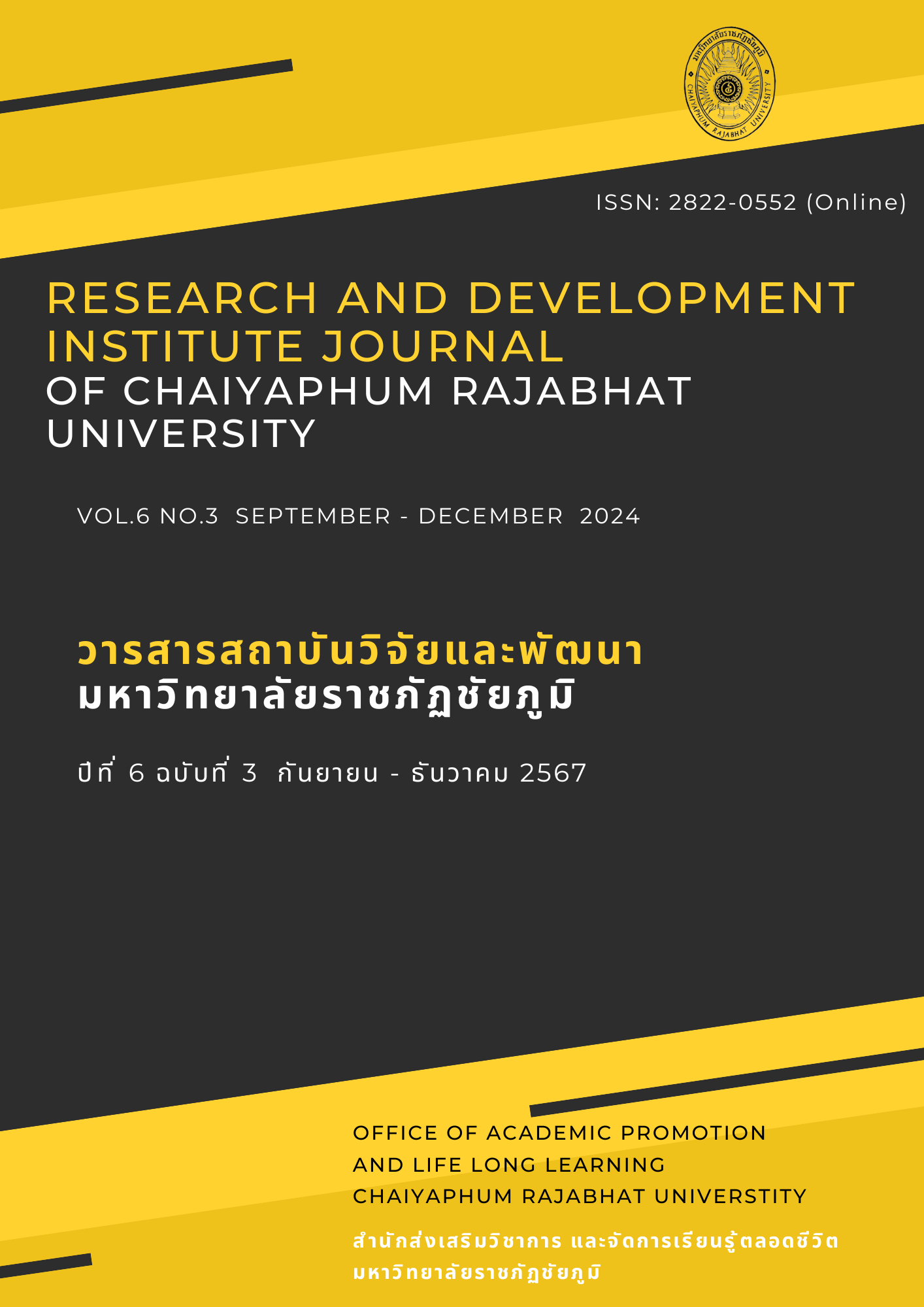SOCIAL STUDIES BOARD GAME DESIGN: THE 'GOODNESS' BOARD GAME FOR GRADE 5 STUDENTS
Main Article Content
Abstract
Board games gained popularity and were integrated into education in the country, particularly in social studies. The content related to religion often involved abstract concepts, leading to student boredom and difficulty in understanding the material. The researcher, therefore, aimed to study and design the "Goodness" board game for fifth-grade students as an alternative tool for teachers interested in using it for learning management. This research employed a mixed-methods approach. A panel of three experts, selected based on their expertise and experience in educational games, participated in meetings to provide feedback for refining and improving the board game. An evaluation form was used to assess the suitability of the board game, employing content analysis for expert meeting data and basic statistical analysis, including mean and standard deviation, for data interpretation from the evaluation form. The findings revealed five components of the board game: 1) introduction (game information), 2) game rules, 3) question-and-answer cards, 4) chance cards, and 5) game board. The board game’s key feature was its mechanism that encouraged students to learn through play. The question cards helped students understand the content, while the chance cards added an element of challenge. The evaluation results indicated that the board game’s suitability was rated as excellent.
Article Details

This work is licensed under a Creative Commons Attribution-NonCommercial-NoDerivatives 4.0 International License.
Permission to use text, content, images, etc. of publication. Any user to read, download, copy, distribute, print, search, or link to the full texts of articles, crawl them for indexing, pass them as data to software, or use them for any other lawful purpose. But do not use it for commercial use or with the intent to benefit any business. Published under a Creative Commons Attribution-NonCommercial-NoDerivatives 4.0 International License.

This work is licensed under a Creative Commons Attribution-NonCommercial-NoDerivatives 4.0 International License
References
กระทรวงศึกษาธิการ. (2551). หลักสูตรแกนกลางการศึกษาขั้นพื้นฐาน พุทธศักราช 2551. โรงพิมพ์ชุมนุมสหกรณ์การเกษตรแห่งประเทศไทย จำกัด.
นเรศ วงค์สถาน. (2567). รายงานผลการปฏิบัติงานข้าราชการครูและบุคลากรทางการศึกษา โรงเรียนราชประชานุเคราะห์ 15 (เวียงเก่าแสนภูวิทยาประสาท). โรงเรียนราชประชานุเคราะห์ 15 (เวียงเก่าแสนภูวิทยาประสาท).
บุญชม ศรีสะอาด. (2545). การวิจัยเบื้องต้น (พิมพ์ครั้งที่ 7). สุวีริยาสาส์น.
พระสิทธิชัย รินฤทธิ์, และสุรีพร ชาบุตรบุณฑริก. (2563). การจัดการเรียนการสอนสังคมศึกษาในศตวรรษที่ 21. Journal of Roi Kaensarn Academi, 5(2), 204-212.
วันหรรษา ธเนศจิรัสย์. (2565). การออกแบบบอร์ดเกมเพื่อพัฒนาสมรรถนะพหุวัฒนธรรมเชิงศาสนาในนักเรียนระดับมัธยมศึกษาปีที่ 1. [วิทยานิพนธ์ศึกษาศาสตรมหาบัณฑิต]. มหาวิทยาลัยธรรมศาสตร์.
สุวิทย์ มูลคำ. (2550). กลยุทธ์การสอนวิเคราะห์ (พิมพ์ครั้งที่ 4). ภาพพิมพ์.
สุภัค แก้วศรีปัญ, และชรินทร์ มั่งคั่ง. (2566). การจัดการเรียนรู้สังคมศึกษาแบบใช้ปัญหาเป็นฐานร่วมกับการสร้างสรรค์เป็นฐานเพื่อส่งเสริมทักษะการคิดเชิงพหุทรรศน์ ของนักเรียนระดับชั้นมัธยมศึกษาตอนต้นโรงเรียนวัฒโนทัยพายัพ จังหวัดเชียงใหม่. วารสารวิชาการ สถาบันเทคโนโลยีภาคตะวันออกแห่งสุวรรณภูมิ, 2(1), 17-29.
อธิป อนันต์กิตติกุล, และเพ็ญพนอ พ่วงแพ. (2565). การเรียนรู้โดยการใช้เกมดิจิทัลเป็นฐานในการเรียนการสอนวิชาสังคมศึกษา. วารสารศึกษาศาสตร์ มหาวิทยาลัยศิลปากร, 20(1), 130-142.
Adipat, S., Laksana, K., Busayanon, K., Ausawasowan, A., & Adipat, B. (2021). Engaging Students in the Learning Process with Game-Based Learning: The Fundamental Concepts. International Journal of Technology in Education, 4(3), 542–552. https://doi.org/10.46328/ijte.169
Bonwell, C. C., & Eison, J. A. (1991). Active learning: Creating excitement in the classroom. ASHE-ERIC Higher Education Report No. 1. The George Washington University, School of Education and Human Development.
Creswell, J. (2008). Educational research: Planning, conducting and evaluating quantitative and qualitative research (3rd ed.). Pearson Prentice Hall.
Dawadi, S., Shrestha, S., & Giri, R. A. (2021). Mixed-Methods Research: A Discussion on its Types, Challenges, and Criticisms. Journal of Practical Studies in Education, 2(2), 25–36. https://doi.org/10.46809/jpse.v2i2.20
Fredricks, J. A., Blumenfeld, P. C., & Paris, A. H. (2004). School engagement: Potential of the concept, state of the evidence. Review of Educational Research, 74(1), 59-109.
Gee, J. P. (2003). What video games have to teach us about learning and literacy. Palgrave Macmillan.
Kirriemuir, J., & McFarlane, A. (2004). Literature review in games and learning. Futurelab.
Kolb, D. A. (1984). Experiential Learning: Experience as the Source of Learning and Development. Prentice Hall.
Kuh, G. D., Cruce, T. M., Shoup, R., Kinzie, J., & Gonyea, R. M. (2008). Unmasking the effects of student engagement on first-year college grades and persistence. The Journal of Higher Education, 79(5), 540-563.
Maguth, B. M., List, J. S., & Wunderle, M. (2014). Teaching social studies with video games to elementary school students. The Social Studies, 106(1), 32-36.
Mayer, R. E., Bekebrede, G., Harteveld, C., Warmelink, H., Zhou, Q., van Ruijven, T., Lo, J., Kortmann, R., & Wenzler, I. (2014). The research and evaluation of serious games: Toward a comprehensive methodology. British Journal of Educational Technology, 45(3), 502-527.
Plass, J. L., Homer, B. D., & Kinzer, C. K. (2015). Foundations of Game-Based Learning. Educational Psychologist, 50(4), 258–283. https://doi.org/10.1080/00461520.2015.1122533
Prensky, M. (2001). Digital game-based learning. McGraw-Hill.
Sardone, N. B., & Devlin-Scherer, R. (2016). Let the (board) games begin: Creative ways to enhance teaching and learning in elementary social studies. The Clearing House: A Journal of Educational Strategies, Issues and Ideas, 89(6), 215-222.

